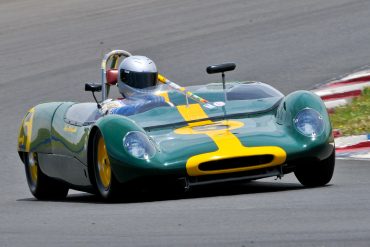Prices are based on an average of values submitted by our panel of expert consultants who this month include: Jack...
Prices are based on an average of values submitted by our panel of expert consultants who this month include: Lance...
The Canadian American Challenge Cup (Can-Am) was co-sanctioned by the SCCA and CASC; it was a series nicknamed the “unlimited” series. Although there was a basic set of rules, the cars had to be two-seaters with bodywork covering the wheels, doors, a windscreen, brake lights and meet various safety requirements....
The Canadian American Challenge Cup (Can-Am) was cosanctioned by the SCCA and CASC; it was a series nicknamed the “unlimited”...
The Canadian American Challenge Cup was co-sanctioned by the SCCA and CASC—it was a series nicknamed the “unlimited” series. Although...
The Canadian American Challenge Cup was co-sanctioned by the SCCA and CASC—it was a series nicknamed the “unlimited” series. Although there was a basic set of rules, the cars had to be two-seaters with bodywork covering the wheels, have doors, a windscreen, brake lights and various safety requirements. However, there...
The Canadian American Challenge Cup was co-sanctioned by the SCCA and CASC—it was a series nicknamed the “unlimited” series. Although...
The Canadian American Challenge Cup was co-sanctioned by the SCCA and CASC, and quickly became known as the “unlimited” series....
The Canadian-American Challenge Cup was a series nicknamed the “unlimited” series co-sanctioned by the Sports Car Club of America and the Canadian Automobile Sport Clubs. Although there was a basic set of rules—the cars had to be two-seaters with bodywork covering the wheels, have doors, a windscreen, brake lights, and...
By almost anyone’s measure, one of the things that made the Golden Era golden was the Canadian-American Challenge Cup or...
The Canadian American Challenge Cup was co-sanctioned by the SCCA and CASC—it was a series nicknamed the “unlimited” series. Although...
The Canadian American Challenge Cup was co-sanctioned by the SCCA and CASC—it was a series nicknamed the “unlimited” series. Although there was a basic set of rules, the cars had to be two-seaters with bodywork covering the wheels, have doors, a windscreen, brake lights, and various safety requirements. However, there...
The Canadian American Challenge Cup, co-sanctioned by the SCCA and the CASC, was essentially an “unlimited” series. Although there was...
The Canadian-American Challenge Cup was co-sanctioned by the SCCA and CASC; it was a series nicknamed the “unlimited” series. Although...
From the very beginning of the automobile man built cars to compete with a passion for speed and technology. These innovators are in an elite club with their place in automotive history guaranteed as the creators of a true classic sports car, a genuine thoroughbred. The development of the racing...
The Canadian American Challenge Cup was co-sanctioned by the SCCA and CASC; it was a series nicknamed the “unlimited” series....
From 1964 to 1978, a series of flat-bottomed, formula cars were manufactured to serve as a stepping stone to Formula...
The Canadian-American Challenge Cup was an “unlimited” racing series co-sanctioned by the SCCA in America and the CASC in Canada. Although governed by a basic set of rules—the cars had to be two-seaters with bodywork covering the wheels, have doors, a windscreen, brake lights and various safety requirements—there were no...
The Canadian-American Challenge Cup was co-sanctioned by the SCCA and CASC; it was nicknamed the “unlimited” series. Although there was...
The Canadian American Challenge Cup was co-sanctioned by the SCCA and the CASC; it was a series nicknamed the “unlimited”...
Formula Ford was a specification racing series created on the idea that the best drivers would win if they were racing identical cars. The idea for this low-budget formula was created by an Englishman named Geoffrey Clarke, who had a driver’s school called Motor Racing Stables based at the Brands...
The under 2-liter Grand Touring (GT) cars have always had a place to compete within the ever-changing regulations of international...
From the very beginning of the automobile, man built cars to compete with a passion for speed and technology. These...
The Canadian American Challenge Cup was co-sanctioned by the SCCA and the CASC; it was a series nicknamed the “unlimited” series. Although there was a basic set of rules, the cars had to be twoseaters with bodywork covering the wheels, have doors, a windscreen, brake lights and various safety requirements,...
From the very beginning of the automobile, men with a passion for speed and technology built cars to compete. These...
The FIA sports prototypes were some of the most exciting purpose-built racing cars ever designed. They competed under the regulations...
From 1964 to 1978, a series of flat-bottomed formula cars were manufactured to serve as steppingstones to Formula One and the upper echelons of open-wheel racing. In the late ’50s, F2 and F3 were consolidated into Formula Junior. However, with that category’s demise at the end of 1963, F2 was...
Two-liter sports racing cars have always had a place to compete within the ever-changing regulations of international motorsports; the World...
The Formula Junior category was introduced in Italy in 1958 by Count Giovanni Lurani, and in 1959 it became an...
Over two-liter Grand Touring cars have always had a place to compete within the ever-changing regulations of international motorsports; the World Sports Car Championship from 1953-1961, the Speedworld Challenge from 1962-1963, and the International Championship of Makes from 1972-1981. This included racing in the great endurance races such as the...
































